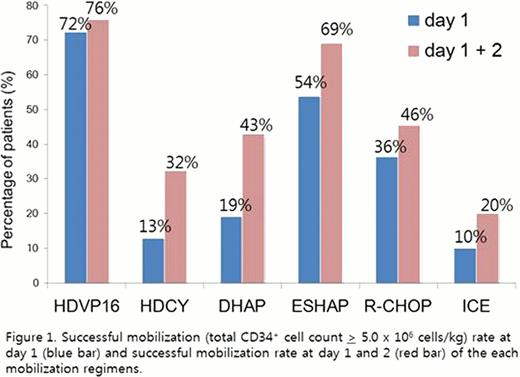Abstract
Abstract 1917
High-dose chemotherapy followed by autologous stem cell transplantation (ASCT) is a curative treatment in patients with non-Hodgkin's lymphoma (NHL). Various regimens have been used to mobilize the peripheral blood stem cell (PBSC). Recently, etoposide plus G-CSF is considered to be one of the effective mobilization regimen in NHL without increasing risk of tMDS/AML. But the efficacy and the toxicity of high dose etoposide plus G-CSF compared with other mobilization regimens are not well defined. So, we conducted a retrospective multicenter study to compare the efficacy and the toxicity of various mobilization regimens.
A total of 115 patients with NHL who were treated only with Rituximab –CHOP (cyclophosphamide, doxorubicin, vincristine, prednisolone) or CHOP chemotherapy and sequentially underwent PBSC mobilization between 2006 and 2011 were analyzed. For PBSC mobilization, six kinds of chemo-mobilization regimens were used. Twenty nine patients received etoposide 1.5 g/m2 (HDVP16 group), 31 patients received high dose cyclophosphamide 4 g/m2 (HDCY group), 21 patients received DHAP (cisplatin, cytarabine, dexamethasone) regimen (DHAP group), 13 patients received ESHAP (etoposide, methylprednisolone, cytarabine, cisplatin) regimen (ESHAP group), 11 patients received R-CHOP (R-CHOP group) and 10 patients received ICE (ifosfamide, carboplatin, etoposide) regimen (ICE group). All patients administered G-CSF 10 ¥ìg/kg/day until apheresis completed. Efficacy of PBSC mobilization and chemotherapy related toxicities were compared between the groups.
Among the various mobilization regimens, high dose etoposide plus G-CSF was the most effective regimen for PBSC mobilization. A median total CD34+cells collected was highest in HDVP16 group (16.22 × 106 cells/kg) compared with other regimens (4.44 in the HDCY group, 12.00 in the DHAP group, 6.08 in the ESHAP group, 4.03 in the R-CHOP group, 2.37 in the ICE group, P<0.001). Successful mobilization (total CD34+ cell count > 5.0 × 106 cells/kg) rate at day 1 and successful mobilization rate at day 1 and 2 were 72.4 % and 75.9 % in the HDVP16 group, which was significantly higher than the HDCY group (12.9 % and 32.3 %), the DHAP group (19.0 % and 42.9 %), the R-CHOP group (36.4 % and 45.5 %) and the ICE group (10.0 % and 20.0 %) (P=0.017 and P=0.045). Only in the HDVP16 group, no patient failed to mobilize stem cell adequately (failure to mobilization: total CD34+ cell count < 2.0 × 106 cells/kg). In univariate analysis, successful stem cell mobilization at day 1 was independently influenced by mobilization regimen, especially high-dose etoposide regimen (Exp 23.625, P=0.005) and ESHAP regimen (Exp 10.500, P=0.049). Neutropenic fever, none of which were fatal, developed in 20 patients (68.2 %) in the HDVP16 group which was more frequent significantly than in the other regimens (14.3 % (P<0.001) in the DHAP group, 7.7 % (P=0.001) in the ESHAP group, 27.3 % (P=0.031) in the R-CHOP group, 10.0 % (P=0.003) in the ICE group). But incidence of neutropenic fever was similar between the HDVP16 group and the HDCY group (68.2 % vs 58.1 % (P=0.454)).
High dose etoposide improves the effectiveness of mobilization with higher stem cell yield compared with other mobilization regimens. Especially when compared to high dose cyclophosphamide regimen, high dose etoposide regimen showed higher efficacy for mobilization and similar incidence of neutropenic fever. Although high dose etoposide regimen showed longer duration of neutropenia and higher incidence of neutropenic fever than other regimens, there is no mortalities and grade IV infections. High dose etoposide plus G-CSF, when compared with other mobilization regimens, is a highly effective mobilization regimen with acceptable toxicity in patients with NHL.
No relevant conflicts of interest to declare.
Author notes
Asterisk with author names denotes non-ASH members.


This feature is available to Subscribers Only
Sign In or Create an Account Close Modal